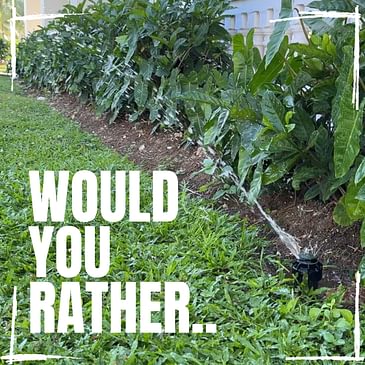In the episode of the "Sprinkler Nerd Show," host Andy Humphrey and his guest, Paul, embark on a detailed discussion about the technical aspects of irrigation systems, specifically focusing on the importance of flow and pressure monitoring.
Andy begins by recounting his observations of inefficient sprinkler systems at a resort, noting that a vast majority are functioning poorly. He suggests that the resort's irrigation system is so ineffective that it might as well not be in operation. This real-world issue leads him to reflect on the broader implications for the irrigation industry, particularly the innovations in flow and pressure monitoring technologies.
To dive deeper into the topic, Andy introduces a thought experiment based on the game "Would You Rather?" The game is simple: one person poses a dilemma in the form of a question starting with "would you rather," and the other person chooses one of the options. Andy uses this format to pose a significant question to Paul: Given a choice between flow monitoring and pressure monitoring for a commercial irrigation system, which one would you choose?
Paul acknowledges the complexity of the question. Traditionally, the industry relied heavily on flow monitoring, with pressure monitoring being a more recent development. He expresses a preference for both but understands that the question demands a choice.
The conversation shifts to an in-depth analysis of the two monitoring methods. Flow monitoring is essential for understanding water usage and identifying leaks through abnormal flow patterns. It is a vital tool for water conservation and efficient system management. On the other hand, pressure monitoring provides diagnostic insights that are not immediately apparent through flow data alone. For instance, pressure fluctuations can indicate issues with the municipal water supply that could affect irrigation system performance.
Andy and Paul discuss the scenarios where one type of monitoring may be more advantageous than the other. For example, Paul shares an anecdote about a situation in Washington, D.C., where several irrigation systems under his management experienced a drop in performance due to a reduction in municipal water pressure. This incident underscores the value of pressure monitoring, as it can provide early warnings about changes in water supply that are beyond the control of the irrigation system manager.
The discussion delves into the practicalities of managing large-scale irrigation systems. They examine how continuous logging of pressure data can provide insights that intermittent readings cannot. Paul points out that as municipal water systems age, providers often reduce water pressure to extend the lifespan of the infrastructure, impacting irrigation systems connected to the municipal supply. This practice, while beneficial to the municipal system, can have unintended consequences for irrigation, making pressure monitoring an invaluable tool for understanding and adapting to these external changes.
As they further explore the nuances of flow and pressure data, Andy and Paul consider the implications of having one without the other. They agree that while flow sensors are crucial for accounting for water usage, pressure sensors offer a more sensitive diagnostic tool that can help explain why certain anomalies in water usage may occur.
Andy then offers a perspective that connects the physical observations of an irrigation system to the data provided by sensors. Walking around the resort, he notices visible signs of system failure, such as broken infrastructure and poorly performing sprinkler zones. He posits that either a flow sensor or a pressure sensor could indicate such problems, but each does so in a different way. A flow sensor could detect a broken pipe through abnormal water usage, while a pressure sensor could indicate a drop in performance due to pressure changes.
As they wrap up their discussion, both Andy and Paul lean towards the importance of pressure monitoring when forced to choose. They liken pressure sensors to a doctor checking blood pressure—a critical first step in diagnosing a patient's health. They explore the idea that while flow is a measurement of consumption, pressure provides a more immediate reflection of system health.
Paul highlights that from a management standpoint, pressure data is more actionable, especially when monitoring remotely. He also notes that installing pressure sensors can be simpler and less intrusive than installing flow sensors, which often require cutting into the mainline. This ease of installation makes pressure sensors a more attractive option for quickly and cost-effectively assessing system performance.
In conclusion, Andy and Paul's conversation in the "Sprinkler Nerd Show" episode brings to light the strategic importance of choosing the right monitoring tools for irrigation systems. They discuss the trade-offs between flow and pressure monitoring and conclude that while both are essential, pressure monitoring may offer a slight edge in terms of diagnostics and system management, particularly when faced with the constraints of municipal water supplies and the need for remote system oversight. Their dialogue is a testament to the evolving technological landscape of irrigation and the need for professionals in the field to adapt and make informed decisions about the tools they use to manage water resources effectively.





